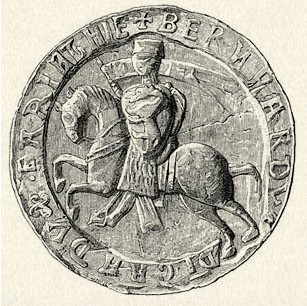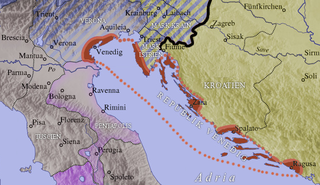Related Research Articles

The Duchy of Carinthia was a duchy located in southern Austria and parts of northern Slovenia. It was separated from the Duchy of Bavaria in 976, and was the first newly created Imperial State after the original German stem duchies.
Henry the Proud, a member of the House of Welf, was Duke of Bavaria from 1126 to 1138 and Duke of Saxony as well as Margrave of Tuscany and Duke of Spoleto from 1137 until his death. In 1138 he was a candidate for the election as King of the Romans but was defeated by Conrad of Hohenstaufen.

Henry IX, was a member of the House of Welf, a powerful dynasty in medieval Germany. He was born around 1075 and died in 1126. Henry IX is often referred to as “Henry the Black” and ruled as Duke of Bavaria from 1120 until his death in 1126.

Berthold IV, a member of the House of Andechs, was Margrave of Istria and Carniola. By about 1180/82 he assumed the title of Duke of Merania, referring to the Adriatic seacoast of Kvarner which his ancestors had conquered in the 1060s and annexed to Istria and Carniola.

The Marchof Carniola was a southeastern state of the Holy Roman Empire in the High Middle Ages, the predecessor of the Duchy of Carniola. It corresponded roughly to the central Carniolan region of present-day Slovenia. At the time of its creation, the march served as a frontier defense against the Kingdoms of Hungary and Croatia.

The March of Tuscany was a march of the Kingdom of Italy and the Holy Roman Empire during the Middle Ages. Located in northwestern central Italy, it bordered the Papal States to the south, the Ligurian Sea to the west and Lombardy to the north. It comprised a collection of counties, largely in the valley of the River Arno, originally centered on Lucca.

The March of Verona and Aquileia was a vast march of the Holy Roman Empire in the northeastern Italian region during the Middle Ages, centered on the cities of Verona and Aquileia. Seized by King Otto I of Germany in 952, it was held by the Dukes of Bavaria; from 976 in personal union with the Duchy of Carinthia. The margravial regime ended with the advent of the Lombard League in 1167.

Bernhard von Spanheim, a member of the noble House of Sponheim, was Duke of Carinthia for 54 years from 1202 until his death. A patron of chivalry and minnesang, Bernhard's reign marked the emergence of the Carinthian duchy as an effective territorial principality.

The March of Istria was originally a Carolingian frontier march covering the Istrian peninsula and surrounding territory conquered by Charlemagne's son Pepin of Italy in 789. After 1364, it was the Istrian province of the Habsburg monarchy, the Austrian Empire and Austria-Hungary.
Ulric I, also Odalric or Udalrich, Count of Weimar-Orlamünde, was margrave of Carniola from 1045 and of Istria from 1060 to his death.
Engelbert II, a member of the House of Sponheim, was Margrave of Istria and Carniola from about 1103/07 until 1124. In 1123, he succeeded his elder brother Henry as Duke of Carinthia and Margrave of Verona which he held until his retirement in 1135.
The House of Sponheim or Spanheim was a medieval German noble family, which originated in Rhenish Franconia. They were immediate Counts of Sponheim until 1437 and Dukes of Carinthia from 1122 until 1269. Its cadet branches ruled in the Imperial County of Ortenburg-Neuortenburg and various Sayn-Wittgenstein states until 1806.

The House of Andechs was a feudal line of German princes in the 12th and 13th centuries. The counts of Dießen-Andechs obtained territories in northern Dalmatia on the Adriatic seacoast, where they became Margraves of Istria and ultimately dukes of a short-lived imperial state named Merania from 1180 to 1248. They were also self-styled lords of Carniola.

Berthold III, a member of the Bavarian House of Andechs, was Margrave of Istria from 1173 until his death.
Herman II of Spanheim, a scion of the Rhenish House of Sponheim, was Duke of Carinthia from 1161 until his death.
Adelheid of Wolfratshausen was a countess of Sulzbach as the second wife of Berengar II, Count of Sulzbach. Slightly different dates for her death are given in the necrologies of Tegernsee and the Salzburg Cathedral.
Siegfried I is considered the progenitor of the Carinthian ducal House of Sponheim (Spanheimer) and all of its lateral branches, including the Counts of Lebenau and the Counts of Ortenburg. He is documented as Count of Sponheim from 1044 and served as margrave of the Hungarian March in 1045/46 and as count in the Puster Valley and the Lavant Valley from 1048 until his death.

Matilda of Andechs was a daughter of Margrave Berthold I of Istria and his first wife, Hedwig of Dachau-Wittelsbach, daughter of the Bavarian Count palatine Otto IV of Scheyern.

Pellegrino II was Patriarch of Aquileia in northern Italy from 1195 to 1204.
Engelbert I was Margrave of Istria (1090–1096), Count of Sponheim, Kraichgau, and Pustertal and Vogt of the Archbishopric of Salzburg. As a supporter of Pope Gregory VII during the Investiture Controversy, he lost the county of Pustertal. In 1091, Engelbert founded the Benedictine monastery of St. Paul. He retired as a monk there in 1095 and died in 1096.
References
- ↑ In contemporary documents marchio Ystrie and marchio de Hystria
- ↑ Loud & Schenk 2017, p. xxxii.
- ↑ Williams 1935, p. xxv, 134-136.
- ↑ Bannato, U. (11 February 2008). "I Patriarchi Ghibellini di Aquileia" . Retrieved 2013-11-30.